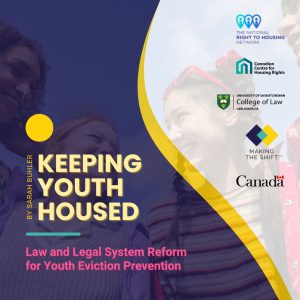
In the words of American scholar Kathryn Sabbeth, eviction is not a natural occurrence but rather is the “product of the legal system that political leaders have chosen to construct.”
In other words: laws and legal processes create evictions—a pathway that often leads to long-term housing instability, homelessness, and is associated with poor social, educational, and health outcomes. Preventing youth evictions, therefore, should be a key priority for policy makers and housing advocates.
This research paper was written by Sarah Buhler, an Associate Professor at the University of Saskatchewan College of Law. Her research focuses on eviction law and practice.
Sarah is part of a team with the National Right to Housing Network and the Canadian Centre for Housing Rights who are working on a project to answer the fundamental question: can we build a youth-centred and human rights-informed approach to eviction law and practice that prioritizes eviction prevention? To learn more about our joint project, click here.
Background
A focus on law and legal processes is important when we are thinking about eviction prevention because, simply put—law helps create eviction.
For example, all jurisdictions have residential tenancies statutes that set out rules about landlord-tenant relationships and set out grounds for eviction (for example, non-payment of rent by the tenant, or a landlord’s desire to renovate or occupy the rental unit), as well as procedures for eviction processes. These processes are then enforced by a Sheriff or other official who is empowered to physically remove a tenant and their family from their home.
However, if law can help create evictions and the conditions for evictions, then law can also build in commitments to ensure that the most vulnerable tenants experience greater security of tenure, and fewer evictions.
What this Paper Covers
The focus of this paper is on eviction legal systems themselves, which are most directly responsible for eviction. As such, this paper defines eviction legal systems as the legislation, policy, case law, courts, and tribunals that govern evictions. It considers how these systems can be transformed to prioritize youth eviction prevention and housing stability for youth. This paper is also intended to contribute to the growing body of Canadian research and scholarship on the human right to housing and youth eviction prevention.
This paper is divided in four main sections:
1. Context on Evictions in Canada 
This paper defines eviction as a tenant’s involuntary loss of their home as a result of a landlord’s words or actions.
Eviction prevention, in contrast, is any program, policy, or intervention that is aimed at keeping people in their rented home with security of tenure (Schwan et al, 2018).
Eviction can be “formal” or “informal.” “Informal” evictions happen outside the legal process—for example, when a tenant moves out of their home after a landlord threatens an eviction process. “Formal” evictions are enacted as a result of a legal process, usually when a landlord applies for a hearing at a provincial or territorial residential tenancies tribunal. Many experts believe that informal evictions outnumber formal ones.
Because formal eviction processes make it easy and efficient for landlords to evict their tenants, tenants may feel that contesting an eviction or asserting their rights is not worthwhile. This exacerbates the power imbalances that exist in landlord-tenant relationships.
Eviction legal processes in Canada generally do not prioritize a prevention focus in their work, instead focusing on efficiency and enforcing landlords’ rights to possession.
 2. Impacts of Evictions on Youth
2. Impacts of Evictions on Youth
Youth are particularly vulnerable to discrimination and exploitation when they are renters, and this disadvantage is profoundly intersectional. For example, youth report difficulty accessing affordable and decent rental housing due to age and income-based discrimination.
Youth are also among the groups most likely to experience eviction from rental housing, with Indigenous, newcomer, LGBTQ2S+ youth, youth with disabilities or who are single parents, and youth who have been involved with the child welfare system facing the highest risk of eviction (Gaetz et al, 2018; Youngbloom et al, 2022). In other words, the risk of eviction rises along with vulnerability and layers of systemic disadvantage.
It is also imperative to emphasize that structural conditions produce youth housing precarity. For example, child welfare systems and youth criminal justice systems often leave young people vulnerable to housing insecurity. Eviction is associated with a myriad of highly negative social, economic, and health outcomes for those who experience it, and can be particularly harmful for youth and children.
Because youth experience homelessness at disproportionate rates (26% of homeless people in Canada are under the age of 24) (Porter, Schwan & Raza, 2022), special efforts should be made to address youth eviction risks.
3. Eviction Prevention Policies
Eviction prevention requires a multipronged approach, and law and legal system reform must necessarily be accompanied by other eviction prevention initiatives and policies to ensure fewer cases end up in eviction processes in the first place.
Since the majority of evictions across the country are for rental arrears (Federation of Canadian Municipalities, 2008), it seems clear that one of the best ways to prevent eviction is to ensure that tenants can afford their rent. This means stronger efforts must be made to increase the availability of public, co-op, and affordable market housing (particularly designed for youth), and to control the rampant financialization of housing that has been associated with rising unaffordability.
Upstream eviction prevention also requires financial supports such as rental assistance, supplements, and emergency funds to be provided, especially for youth (Schwan et al, 2018). In addition, relevant labour laws, legislation, and policies should also be strengthened to ensure that living wages and social assistance rates comply with human rights obligations.
Importantly, “wraparound” supports and accessible, youth-centred educational initiatives are also essential tools needed for eviction prevention.
4. Reforming the Legal System: How Law and Legal Systems Can Prevent Youth Evictions
Canada declared housing to be a human right for all in the 2019 National Housing Strategy Act (NHSA). A shift to a human rights lens would involve centring the human need for shelter, security, and a place to call home, and to recognize that “housing is essential to the inherent dignity and well-being of the person” (National Housing Strategy Act, 2019).
Despite the NHSA being in place, however, most individual provinces and territories have yet to explicitly revise residential tenancies legislation to reflect a human rights lens. As a result, eviction decisionmakers tend to view eviction as the only possible solution to address a wide variety of tenancy issues and problems (Canadian Centre for Human Rights, 2023a).
In addition, international human rights law makes it clear that eviction into homelessness is a gross violation of human rights (Special Rapporteur on the Right to Adequate Housing). And while these international laws do not prohibit evictions, they do provide some guideposts to inform eviction law processes.
For example, in accordance with international human rights guidelines, a human rights approach to eviction would require all parties to never treat eviction as a routine matter, and to ensure that all reasonable measures are taken to prevent eviction. (For more on how international law can help guide a more human rights-based approach to preventing youth eviction, read our first post of this blog series here.)
Supporting Participation
In addition to more thoroughly implementing the human right to housing into Canada’s legal systems, supporting youth in their ability to fully participate in eviction proceedings can help prevent eviction. However, we know that youth often face barriers in accessing justice in eviction matters These barriers include a lack of knowledge of tenant rights, feeling intimidated by the legal processes, and technological and logistical barriers, particularly for low-income youth.
Studies have shown that tenants who had access to legal assistance experienced better outcomes, and eviction rates go down. However, the availability of legal assistance varies by jurisdiction, very few provide duty counsel assistance through their civil legal aid programs, and most do not fund legal assistance for tenants facing eviction.
Given the often dire consequences of eviction, and the particular negative impacts on youth, provinces and territories should ensure that all tenants have access to legal advocacy or representation in eviction matters, prioritizing cases that affect youth and children.
Tribunals should also be empowered to make orders where necessary to require that responsible governments provide assistance to prevent eviction or ensure adequate alternative housing where children and youth would be rendered homeless as a result of eviction. Empowering tribunals to order governments to provide support for families and youth facing eviction would have as an underlying value a mandate to prevent child apprehension and fragmentation of families.
Addressing Intersecting Issues & Systems
We know that youth who experience eviction are also often entangled with other systems, including criminal justice and child welfare or family law systems and processes. This is why it is critical to ensure stakeholders (such as tribunal staff, hearing officers, etc.) who work within the eviction legal system are equipped to offer trauma-informed and youth-centred services and that they understand the specific harms that eviction causes for youth.
Reforming Procedures
Finally, eviction legal systems can also implement some procedural reforms that will immediately reduce harm and promote eviction prevention.
For example, legislated timelines for various parts of proceedings could be extended to ensure that tenants have time to prepare for hearings, negotiate with landlords, and plan for alterative housing if necessary. In addition, residential tenancies tribunals should change their metrics of evaluation from current emphases on case volume, speed, and efficiency, to a focus on measuring how many evictions were successfully diverted or avoided.
Looking Ahead
This report discusses the deeply consequential impacts of evictions on youth. It argues that the eviction legal system must confront the
harms of eviction on youth and make reforms that seek to reduce and prevent youth eviction from rental housing.
All reforms must apply youth-centred approaches and be grounded in a recognition that housing is a human right. This means:
- Greater measures to increase access to justice, including access to legal representation, for youth who find themselves facing an eviction process.
- Reforms to legislation to ensure that landlords and responsible governments have positive responsibilities to prevent eviction and, in the case of governments, assist youth who are at risk of homelessness as a result of eviction.
- Procedural reforms and a shift to measuring success based on the number of evictions prevented, to change the “culture” of the eviction legal system to one where the maintenance of housing is valued, and where evictions, especially eviction of youth, children, and families, are rare rather than routine events.
Ultimately, our goal as a society should be more than eviction prevention for youth and children. We must work toward a society where youth not only avoid eviction but where they are able to thrive and meet their full human potential with secure, safe housing, and a sense of home and belonging.
This project is funded by Making the Shift Youth Homelessness Social Innovation Lab (MtS), a member of the Government of Canada’s Networks of Centres of Excellence program. The opinions and interpretations in this publication are those of the author and do not necessarily reflect those of the Government of Canada.





